Preliminary assessment
Carry out a preliminary assessment of the manifestation before recording a description.
The assessment determines if the manifestation requires a separate description, and the granularity and completeness of the description that is required to meet the needs of the cataloguing agency.
The granularity of a manifestation description is dependent on the number of carrier and content components that are present in the manifestation. The completeness of a manifestation description is dependent on the intention to publish or produce it in a single contiguous process or in a set of discrete processes over time.
Assess the manifestation to determine the number and type of related resource entities, and to decide if they are to be associated with the manifestation, noted in the description, or omitted from the description.
The number of items that exemplify a manifestation may be indeterminate and is not generally relevant to the description of a manifestation. An instance of an item describes only characteristics that are specific to the item, including modifications that are made after its publication or production.
An instance of a manifestation may be published or produced in more than one physical or logical part.
The preliminary assessment covers three distinct characteristics that apply to every manifestation:
| Characteristic | Description |
|---|---|
| Units | A manifestation may be published or produced in one or more units. |
| Expressions | A manifestation may embody one or more expressions that realise one or more works. |
| Content Change | A manifestation may embody the content of a work that is planned to be static or to change over time. |
Each characteristic meets one of two mutually exclusive conditions at the broadest level. One of the two conditions for each characteristic must apply to every manifestation:
| Characteristic | Possible Conditions |
|---|---|
| Units | A manifestation is in either one unit or more than one unit. |
| Expressions | A manifestation embodies either one expression or more than one expression. |
| Content Change | A manifestation embodies expressions of works that are either static or are planned to be embodied over time. |
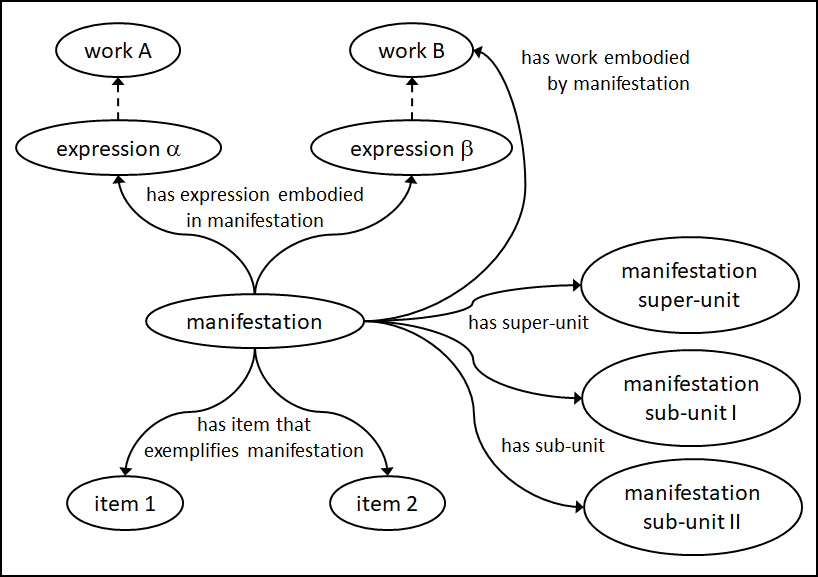
The diagram shows the possible instances of resource entities that may be related to an instance of a manifestation in an information resource.
For each assessment characteristic, determine the number of resource entities that are associated with the manifestation. Apply any mandatory stipulations, and choose one or more of the following options for each instance of a resource entity:
| Option | Description/Action |
|---|---|
| Relationship | Record an appropriate relationship element to associate the instance of a resource entity with the manifestation. |
| Note | Record an appropriate note element to describe one or more instances of a resource entity within the manifestation description. |
| Statement | Record an appropriate manifestation statement element to describe one or more instances of a resource entity within the manifestation description. |
| Omission | Omit the instance of a resource entity from the manifestation description. |
The characteristics to be assessed are mutually independent and are analysed in separate stages. The order of analyses is not important; ISBDM recommends following the order given here.
Manifestation boundaries
The boundary of a manifestation is the set of elements and their sub-types that distinguish the manifestation from other manifestations.
A difference in the information that is associated with these elements indicates a distinct manifestation that requires a separate description if it is to be fully described.
For a manifestation that is published and that embodies one or more expressions of one or more static works, consider the manifestation to be distinct from other manifestations if there is a significant difference in the characteristics of any of the following elements or their sub-types:
For a manifestation that is produced and that embodies one or more expressions of one or more static works, consider the manifestation to be distinct from other manifestations if there is a difference in the characteristics of any of the following elements or their sub-types:
For a manifestation that embodies the expression of a diachronic work, consider the manifestation to be distinct from other manifestations if there is a significant change in the characteristic of any of the following elements:
Number of units
A manifestation may be published or produced in one or more logical or physical parts.
A manifestation inherits the conceptual parts of a work by embodying expressions of the parts. There is no intrinsic relationship between the conceptual parts and the logical or physical parts.
Examples
A manifestation that is a single physical part and a manifestation that has two physical parts can each embody a work or expression that has three conceptual parts.
A logical or physical part is termed a "unit" for clarity. A unit is a logical part of an intangible manifestation or a physical part of a tangible manifestation.
Assess the number and hierarchical structure of units of the manifestation.
Consider a manifestation that is an "online resource" to have more than one logical part if distinct content has its own Uniform Resource Locator (URL) that is based on the root URL of the manifestation. Consider the manifestation to have only one logical part if all content has the root URL. [Full example: myScience Canada (2008-; Scimetrica; online resource). The URLs of the English and French versions share the same root URL and are distinct: "https://www.myscience.ca/" (Home page in English); "https://www.myscience.ca/en" (English version sub-unit); "https://www.myscience.ca/fr" (French version sub-unit).]Examples
Property Value has unitary structure "multiple unit" has sub-unit "myScience Canada (2008-; Scimetrica; online resource; English)" has sub-unit "myScience Canada (2008-; Scimetrica; online resource; French)"
For a manifestation that is two or more unattached sheets, consider each sheet to be a part of the manifestation irrespective of the layout of the content that is embodied in the sheets. [Full example: Burleska pro klarinet a klavír (1945-03-26; Vostřák, Zbyněk; sheet). The manifestation consists of three unbound folded sheets.]Examples
Property Value has unitary structure "multiple unit"
Consider a manifestation that embodies an issue of a successive diachronic work to be a sub-unit of the manifestation that embodies the incomplete diachronic work. The number of sub-units of the manifestation increases over time. [Full example: Hakerska etika i duh informacijskog doba (2002; Naklada Jesenski i Turk; svezak).] [Full example: Biblioteka 42 (2000-; Naklada Jesenski i Turk; svezak)]Examples
Property Value has super-unit "Biblioteka 42 (2000-; Naklada Jesenski i Turk; svezak)" Property Value has sub-unit "Hakerska etika i duh informacijskog doba (2002; Naklada Jesenski i Turk; svezak)"
Consider a manifestation that embodies an iteration of an integrating diachronic work to be the manifestation that embodies the incomplete diachronic work. The number of sub-units of the manifestation may increase or decrease over time. The publisher of a loose-leaf updating service may replace two binders with three binders when a specific iteration is published.Examples
A manifestation may have no more than one super-unit that embodies a static work.
A manifestation may have more than one super-unit that embodies a diachronic work.
The structure of a multiple unit manifestation may form a hierarchy of super-units and sub-units.
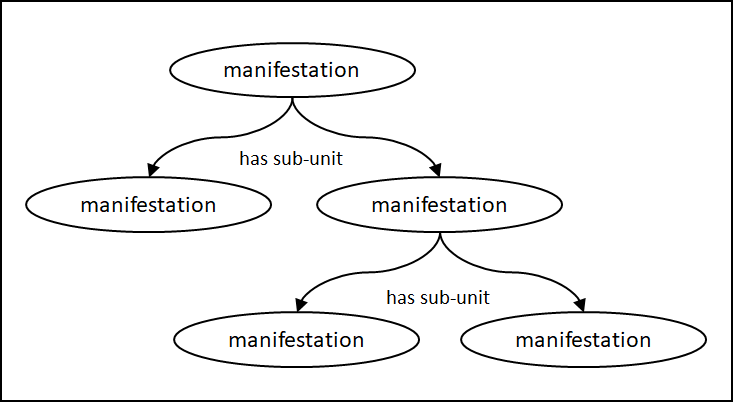
The diagram shows a model of the hierarchy of units in a multiple unit manifestation. A manifestation that has physical or logical parts is a super-unit, and a manifestation that is a physical or logical part is a sub-unit. A unit may have more than one direct sub-unit and a super-unit. A unit is related to a sub-unit with a has sub-unit element and to a super-unit with an inverse has super-unit element.Examples
Property Value has super-unit "Mojo (1993-; H Bauer Publishing Ltd.; volume + audio disc)" has sub-unit "Mojo 357 (2023; H Bauer Publishing Ltd.; volume)" has sub-unit "Stax uncovered! (2023; H Bauer Publishing Ltd.; audio disc)"
Record a value of has unitary structure to indicate that the manifestation is published or produced in one or more units. [Full example: Definitive guide to PSM 1 (2021; Knüeppel, Moritz; volume; perfect binding).] [Full example: Lyceum Theatre, London, England, 5/26/72 (2022; Rhino Entertainment LLC; audio disc).]Examples
Property Value has unitary structure "single unit" Property Value has unitary structure "multiple unit"
Manifestation that is a single unit
For a manifestation that is published or produced in only one unit, record a single description.
Record a has category of carrier element. This is mandatory.
Describe other physical characteristics of the unit by applying any of the following methods:
- Record a has physical characteristic element or element sub-type.
- Record a has extent of manifestation element or element sub-type.
- Record a has note on physical characteristic element.
- Record a has manifestation statement element or element sub-type that includes information about the unit.
Describe the unit with more than one method, if it is considered to be useful for users of the metadata. [Full example: Gruffalo (2020; Macmillan Children's Books; volume; board book binding).] [Full example: Видатнi вченi Нацiональноï академiï наук Украïнi (1998; Нацiональна бiблiотека Украïнi iменi В.I. Веренадського; том).] [Full example: Stax uncovered! (2023; H Bauer Publishing Ltd; audio disc).]Examples
Property Value has category of carrier "volume" has extent of manifestation "1 volume (18 x 18 cm; 10 pages)" has dimensions "18 x 18 cm" has extent of embodied content "10 pages" has manifestation statement of category "A push, pull and slide book" Property Value has category of carrier "том" has extent of manifestation "1 том (306 сторінки)" has extent of embodied content "306 сторінки" Property Value has category of carrier "audio disc" has extent of manifestation "1 audio disc (15 recorded songs in 49 min 14 sec)" has playing time "49 min 14 sec" has extent of embodied content "15 recorded songs"
Manifestation that is more than one unit
The units in a multiple unit manifestation are related in a hierarchical structure.
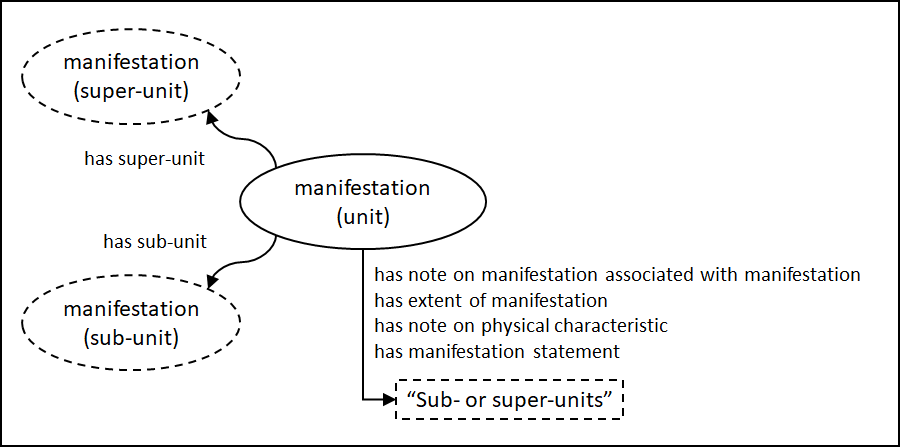
The diagram shows that for a multiple unit manifestation there is a choice of which manifestation units to describe as separate related manifestations and which to include in manifestation statements, extent attributes, or notes for the manifestation that is being described. Optional entities, manifestation statements, and notes are outlined by dashes.
For a manifestation that is published or produced in more than one unit, record at least one single description of the manifestation as a whole, or of one or more of its sub-units, or both.
If the whole manifestation is being described, record a has category of carrier element of one or more of the sub-units. This is mandatory.
Describe other physical characteristics of the sub-units of the manifestation by applying any of the following methods:
-
Record a has sub-unit element.
-
Record a has physical characteristic element or element sub-type.
- Record a has extent of manifestation element or element sub-type.
-
Record a has note on manifestation associated with manifestation element for one or more sub-units.
-
Record a has note on physical characteristic element that includes information about one or more sub-units.
-
Record a has manifestation statement element or element sub-type that includes information about one or more sub-units.
-
Do not describe a sub-unit.
Describe a sub-unit with more than one method, if it is considered to be useful for users of the metadata. [Full example: Revolver (2022; Apple Corps Limited; audio disc; 2 CD edition).]Examples
Property Value has category of carrier "audio disc" has category of carrier "volume" has sub-unit "Revolver (2022; Apple Corps Limited; audio disc; 2 CD edition; CD 1)" has sub-unit "Revolver (2022; Apple Corps Limited; audio disc; 2 CD edition; CD 2)" has sub-unit "Revolver (2022; Apple Corps Limited; audio disc; 2 CD edition; booklet)" has note on physical characteristic "2 CDs and a booklet in a slipcase." has extent of unitary structure "2 audio discs" has extent of unitary structure "1 volume" has manifestation statement of edition "2 CD edition"
If a sub-unit of a manifestation is being described, record a has category of carrier element of the sub-unit. This is mandatory.
Describe other physical characteristics of the super-unit of the manifestation by applying any of the following methods:
- Record a has super-unit element.
- Record a has note on manifestation associated with manifestation element for the super-unit.
- Record a has manifestation statement element or element sub-type that includes information about the super-unit.
- Do not describe the super-unit.
Describe a super-unit with more than one method, if it is considered to be useful for users of the metadata. [Full example: ISBD (2011; De Gruyter Saur; volume).]Examples
Property Value has super-unit "IFLA series on bibliographic control (2004-2012; De Gruyter Saur; volume)" has manifestation statement of issue or iteration "IFLA series on bibliographic control vol 44"
If no statement appears in the manifestation that distinguishes a sub-unit from other sub-units, describe the sub-unit, if it is considered to be useful for users of the metadata. [Full example: Library (2022; Corner Piece Puzzles; object). The manifestation is a jigsaw puzzle. No description of an individual piece of the puzzle is considered to be useful.]Examples
Property Value has unitary structure "multiple unit" has extent of unitary structure "1000 pieces"
Number of expressions
A manifestation may embody one or more expressions that realise one or more works.
Assess the number and dependencies of expressions that are embodied in the manifestation by using the guidance in this section. Decide which of the expressions to include in the description and the methods to use to describe them.
Consider spoken word, tactile text, or text content that is embedded in the manifestation and its packaging in order to describe itself to be a source of information only, and not to be a distinct expression that is embodied in the manifestation.
Consider a manifestation that embodies all of the parts of a larger expression and no other expressions to embody a single whole expression.
Describe the works that are realised by the expressions that are embodied in the manifestation, if it is considered to be useful for users of the metadata. Select the methods to use to describe each work from the following options:
- Record the work as a separate work and record a relationship to it by recording a has work embodied in manifestation element. This shortcut element implies the existence of the expression even though it is not identified.
- Record a has note on work associated with manifestation element that includes a description of the work.
- Record a has manifestation statement element or element sub-type that includes information about the work.
Describe the work with more than one method, if it is considered to be useful for users of the metadata. [Full example: Lyceum Theatre, London, England, 5/26/72 (2022; Rhino Entertainment LLC; audio disc).] [Full example: IFLA series on bibliographic control (2004-2012; De Gruyter Saur; volume).]Examples
Property Value has work embodied in manifestation "Grateful Dead. Lyceum Theatre, London, England, 5/26/72" Property Value has work embodied in manifestation "ISSN 1868-8438"
Record at least one occurrence of a has expression embodied in manifestation or a has work embodied in manifestation element.
Manifestation that embodies one expression
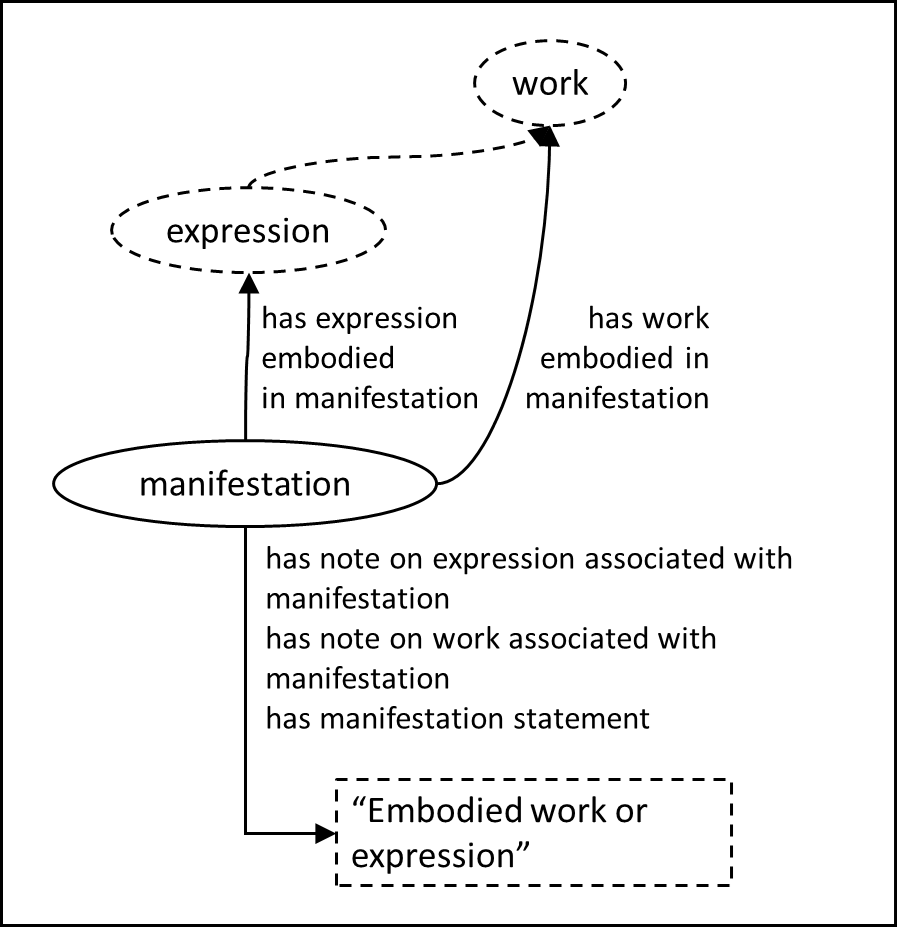
The diagram shows that there is a choice of describing the expression or its work as separate related entities and which to include in manifestation statements or notes for the manifestation that is being described. Optional entities, manifestation statements, and notes are outlined by dashes.
Record a value of a has expression embodied in manifestation element, or record a value of has work embodied in manifestation for the work that is realised by the expression. This is mandatory.
Record both elements, if it is considered to be useful for users of the metadata. [Full example: ISBD (2011; De Gruyter Saur; volume).] [Full example: Loch Morar & Mallaig (2015; Ordnance Survey Ltd; sheet).] [Full example: Harry Potter and the goblet of fire (2000; Listening Library; audiocassette).]Examples
Property Value has expression embodied in manifestation "IFLA ISBD Review Group. ISBD (text; English)" Property Value has work embodied in manifestation "Ordnance Survey. Loch Morar & Mallaig (1:25000)" Property Value has expression embodied in manifestation "Rowling, J.K., 1965-. Harry Potter and the goblet of fire (spoken word; English)" has work embodied in manifestation "Rowling, J.K., 1965-. Harry Potter and the goblet of fire"
Record additional information about the expression or work by applying any of the following methods, if it is considered to be useful for users of the metadata:
- Record a has note on expression associated with manifestation element that includes a description of the expression or record a has note on work associated with manifestation element that includes a description of the work.
- Record a has manifestation statement or element sub-type that includes information about the expression or the work.
Record additional information with more than one method, if it is considered to be useful for users of the metadata.
Manifestation that embodies more than one expression
A manifestation that embodies more than one expression is termed an "aggregate".
Consider an aggregate manifestation to embody also an aggregating expression that realises an aggregating work. The aggregating work is the intention or plan to select the expressions that are embodied in the manifestation.
Consider the aggregating expression as having no intrinsic characteristics that are useful to describe. The aggregating expression does not inherit the characteristics of the expressions that are aggregated, and the common characteristics of the expressions that are aggregated are included in the description of the aggregating work.
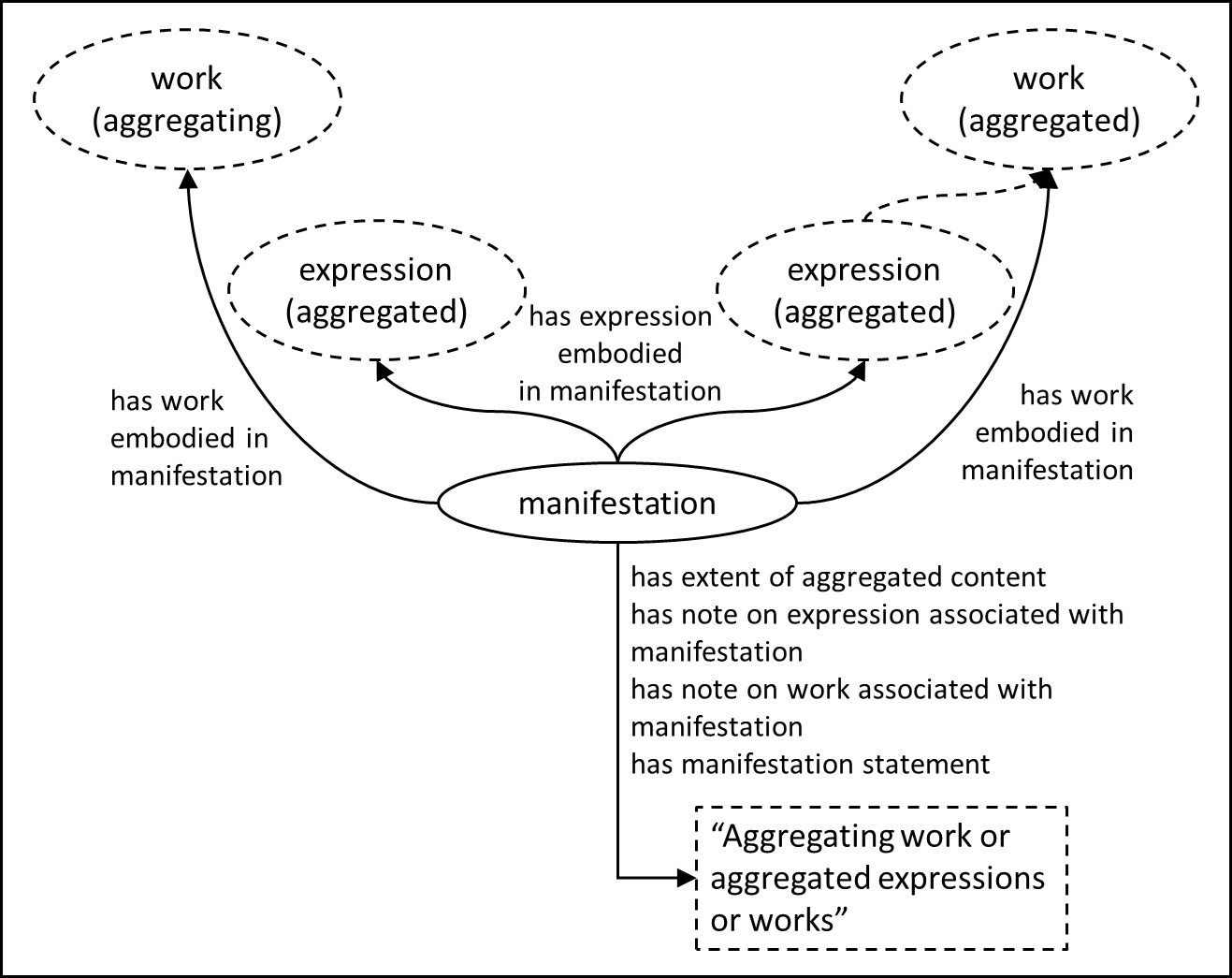
The diagram shows that there is a choice of which expressions or works to describe as separate related expressions and works and which to include in manifestation statements or notes for the manifestation that is being described. Optional entities, manifestation statements, and notes are outlined by dashes.
At least one expression or work must be described as a separate entity and related to the manifestation.
One and only one work that is embodied in the manifestation is the aggregating work. The corresponding aggregating expression is omitted for clarity.
Select the methods to use to describe each expression or work from the following options:
- Record the expression or work as a separate entity and record a relationship to it by recording a has expression embodied in manifestation element or a has work embodied in manifestation element.
- Record a has extent of aggregated content element for the kind of expression.
- Record a has note on expression associated with manifestation element or a has note on work associated with manifestation element that includes a description of the expression or work.
- Record a has manifestation statement or element sub-type that includes information about the expression or work.
- Do not describe the expression or work.
Describe the expression or work with more than one method, if it is considered to be useful for users of the metadata. [Full example: Open licensing for cultural heritage (2017; Facet Publishing; volume; perfect binding).] [Full example: Give it up b/w Tired (2002; Ouput Recordings; audio disc).]Examples
Property Value has expression embodied in manifestation "Hamilton, Gill. Developing open licensing at the National Library of Scotland (text; English)" has note on expression associated with manifestation "Includes a case study of the National Library of Scotland." Property Value has expression embodied in manifestation "LCD Soundsystem. Give it up (performed music)" has expression embodied in manifestation "LCD Soundsystem. Tired (performed music)" has work embodied in manifestation "LCD Soundsystem. Give it up b/w Tired" has extent of aggregated content "2 recorded songs" has manifestation statement of title and responsibility "lcd soundsystem | a. written by james murphy b. by james murphy and pat mahoney | a give it up | james murphy: vocals, bass, drums, percussion, synthesizers, programming | produce by the dfa | b tired | james murphy: vocals, bass, guitar; pat mahoney: drums, percussion; ems synthesizer | produce by the dfa"
The IFLA Library Reference Model identifies three distinct types of aggregate:
- Collected expressions aggregate: A set of expressions of multiple independent works. The expressions may be selected according to a set of common characteristics that apply to the expressions or their works.
- Augmented expression aggregate: An expression of a single independent work that is supplemented by expressions of one or more dependent works. The augmented expression is supplemented with additional content that is not integral to the original work and does not significantly change the expression.
- Parallel expressions aggregate: A set of expressions of a single independent work.
A manifestation may be a mix of types of aggregate that are determined by the intrinsic relationships between the expressions that are aggregated and the works that they realise. [Full example: Black Lizard big book of locked-room mysteries (2014; Vintage Books; volume; perfect binding). The manifestation embodies a collected set of text expressions, and text expressions that augment them.]Examples
The main utility in describing an aggregating expression occurs when the same set of expressions is embodied in alternate manifestations or reproductions. Instead of relating each manifestation to each expression that is aggregated, the aggregating expression can be related to each expression that is aggregated via a shortcut Expression relationship element, and then related to each manifestation with a single has expression embodied in manifestation element.
If the same set of expressions is embodied in more than one manifestation with the same layout of content but with different categories of carrier, record a has expression embodied in manifestation element for the aggregating expression. Do not record elements for the expressions that are aggregated; the expressions that are aggregated are related directly to the aggregating expression.
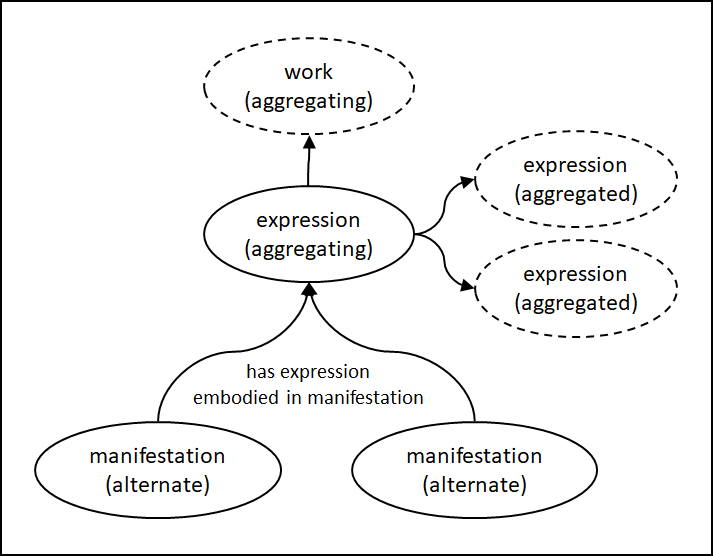
The diagram shows that it can be useful to describe an aggregating expression as a separate related expression if it is embodied in more than one alternate manifestation that is published at the same time, for example in different categories of carrier, or if the same set of expressions is published at a later time. The aggregating expression is related once to each expression that is aggregated, so each alternate or subsequent manifestation may then be related to only the aggregating expression and the direct relationships with the expressions that are aggregated can be omitted. Optional entities, manifestation statements, and notes are outlined by dashes.
Manifestation that embodies augmented expressions
For a manifestation that is an augmented expression aggregate, record a has expression embodied in manifestation or a has work embodied in manifestation element for the augmented expression or work. [Full example: Faded map (2010; Birlinn Limited; volume; case binding).]Examples
Property Value has work embodied in manifestation "Moffat, Alistair, 1950-. The faded map"
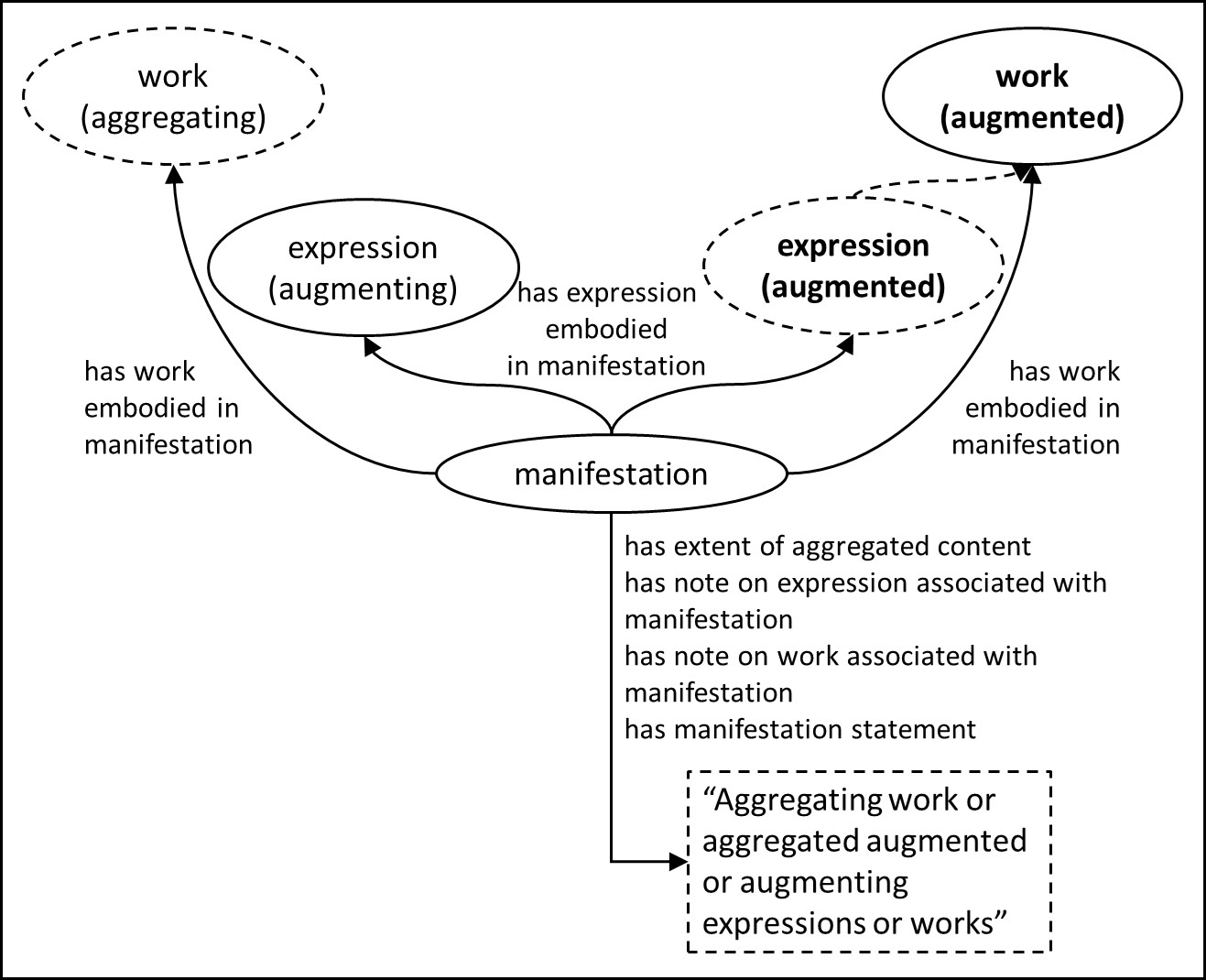
The diagram shows the general case of an augmented expression aggregate. The augmented expression or its work is described as a separate related expression or work. This satisfies the mandatory requirement for a has expression embodied in manifestation element or a has work embodied in manifestation element. There is a choice of which of the augmenting expressions or their works, or of the aggregating work, to describe separately, and which to include in manifestation statements or notes for the manifestation that is being described. The options for entities, manifestation statements, and notes are outlined by dashes.
Record additional occurrences of has expression embodied in manifestation or has work embodied in manifestation elements for expressions or works that are aggregated, and of the aggregating work, if it is considered to be useful for users of the metadata. Use the following order of preference to select the expressions or works:
- The aggregating work that is embodied in the manifestation.
- Expressions that are named and given prominence in a statement of title and responsibility that appears in the manifestation.
- Expressions that are named in a statement of title and responsibility that appears in the manifestation.
- Expressions that are named in other statements that appear in the manifestation.
- Expressions that are identified in the manifestation or in external sources of information.
- Works that are realised by the expressions that are aggregated.
Examples
| Property | Value |
|---|---|
| has expression embodied in manifestation | "Austen, Jane, 1775-1817. Emma (text; English)" |
| has expression embodied in manifestation | "Blythe, Ronald, 1922-2023. Introduction (Emma; text; English)" |
| has work embodied in manifestation | "Blythe, Ronald, 1922-2023. Emma" |
[Full example: Emma (1971; Penguin Books; volume). The augmenting expression and aggregating work are considered to be useful for users of the metadata, in addition to the augmented expression.]
Manifestation that embodies collected expressions
For a manifestation that is a collected expressions aggregate, and if a collective title is given in a statement of title and responsibility, record a has work embodied in manifestation element for the aggregating work that is embodied in the manifestation. [Full example: Knitting the Semantic Web (2007; Howarth Information Press; volume). The manifestation is a collected expressions aggregate with a collective title]Examples
Property Value has work embodied in manifestation "Greenberg, Jane. Knitting the Semantic Web"

The diagram shows the case when the collective title identifies the aggregating work that is embodied in a collected expressions aggregate. In general, the aggregating work is described as a separate related work. This satisfies the mandatory requirement for a has work embodied in manifestation element. There is a choice of which of the collected aggregated expressions or their works to describe as separate related expressions and works, and which to include in manifestation statements or notes for the manifestation that is being described. The options for entities, manifestation statements, and notes are outlined by dashes.
For a manifestation that is a collected expressions aggregate, and if a collective title is not given in a statement of title and responsibility, record a has expression embodied in manifestation or a has work embodied in manifestation element for one of the expressions or works that are aggregated. Use the following order of preference to select the expression or work:
- The first expression or work that is named and given prominence in the typography and layout of a statement of title and responsibility that appears in the manifestation.
- The first expression or work that is named in a statement of title and responsibility that appears in the manifestation.

The diagram shows the case when the aggregating work that is embodied in a collected expressions aggregate is not specifically identified. In general, one of the aggregated collected expressions or their works is selected to be described as a separate related expression or work. This satisfies the mandatory requirement for a has expression embodied in manifestation element or a has work embodied in manifestation element. There is a choice of which of the other aggregated collected expressions or their works to describe as separate related expressions and works, or the aggregating work to describe as a separate related work, and which to include in manifestation statements or notes for the manifestation that is being described. The options for entities, manifestation statements, and notes are outlined by dashes.
For a manifestation that is a collected expressions aggregate, record additional occurrences of has expression embodied in manifestation or has work embodied in manifestation elements for expressions or works that are aggregated, and of the aggregating work, if it is considered to be useful for users of the metadata. Use the following order of preference to select the expressions or works:
- Expressions that are named and given prominence in a statement of title and responsibility that appears in the manifestation.
- Expressions that are named in a statement of title and responsibility that appears in the manifestation.
- Expressions that are named in other statements that appear in the manifestation.
- Expressions that are identified in the manifestation or in external sources of information.
- Works that are realised by the expressions that are aggregated.
- The aggregating work that is embodied in the manifestation without a collective title.
Examples
| Property | Value |
|---|---|
| has work embodied in manifestation | "Eslin, Martin. Absurd drama" |
| has expression embodied in manifestation | "Ionesco, Eugène, 1909-1994. Amédée ou comment s'en débarrasser (text; English)" |
| has expression embodied in manifestation | "Adamov, Arthur, 1908-1970. Professeur Taranne (text; English)" |
| has expression embodied in manifestation | "Arrabal, Fernando, 1932-. Deux bourreaux (text; English)" |
| has expression embodied in manifestation | "Albee, Edward, 1928-2016. Zoo Story (text; English)" |
| has expression embodied in manifestation | "Eslin, Martin, Introduction (Absurd drama; text; English)" |
[Full example: Absurd drama (1978; Penguin Books; volume). The manifestation has a collective title. The collected expressions and augmenting expression are considered to be useful for users of the metadata, in addition to the aggregating work.]
Manifestation that embodies parallel expressions
For a manifestation that is a parallel expressions aggregate, record a has work embodied in manifestation element for the work that is realised by the expressions that are aggregated. [Full example: CD-S303 owner's manual (2021; Yamaha Corporation; online resource). The work is realized in 8 language expressions that are embodied in the manifestation.]Examples
Property Value has work embodied in manifestation "Yamaha Corporation. Manual Development Group. CD-S303 owner's manual"
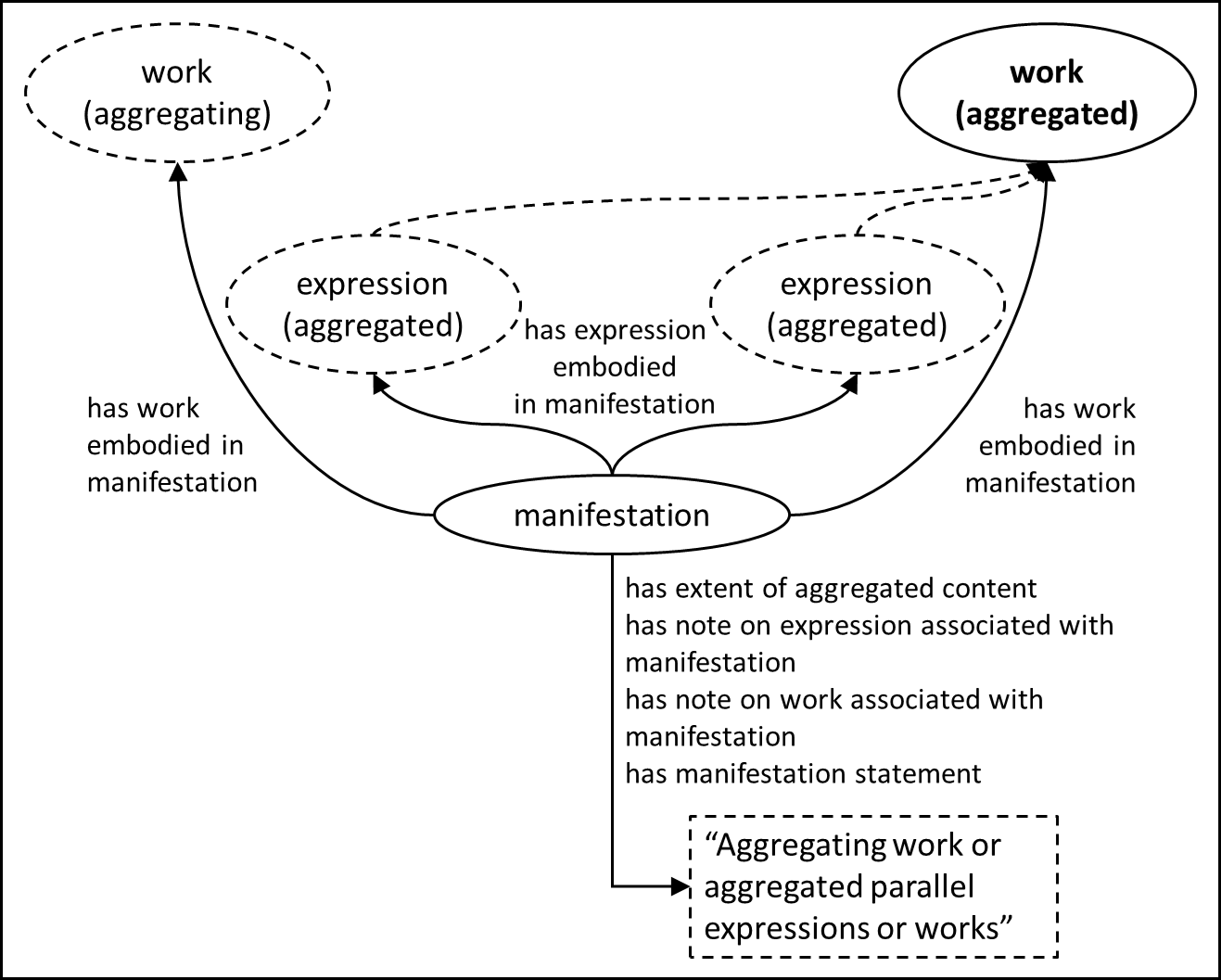
The diagram shows the general case when the work that is realised by each of the expressions that are aggregated in a parallel expressions aggregate is described as a separate related work. This satisfies the mandatory requirement for a has work embodied in manifestation element. There is a choice of which of the aggregated parallel expressions to include in manifestation statements or notes for the manifestation that is being described. The options for entities, manifestation statements, and notes are outlined by dashes.
Completeness of content
A manifestation embodies an expression of a work that is either static or diachronic. A static work is planned to be embodied in a single act of publication or production. A diachronic work is planned to be embodied in multiple acts of publication or production over time.
Assess the static or diachronic nature of the work that is embodied in the manifestation by using the guidance in this section.
A manifestation cannot embody expressions of both a static work and a diachronic work.
An issue or iteration of a diachronic work is a static work. The manifestation that embodies an expression of an issue or iteration of a diachronic work is complete, and is a sub-unit or iteration of the incomplete manifestation that embodies the expression of the diachronic work.
A manifestation that embodies an expression of an issue or iteration of a diachronic work may be indicated by a statement that appears in the manifestation:
- a statement of issue or iteration
- a common title that is included in a statement of title and responsibility
Manifestation that embodies a static work
A manifestation may embody expressions of one or more static works.
A manifestation that embodies expressions of static works is complete and its characteristics will not change over time. It can be described to the level of completeness that is required by users of the metadata. [Full example: Emma (2014 ; Borough Press; volume). The manifestation embodies an expression of a static work.] [Full example: Loch Morar & Mallaig (2015; Ordnance Survey Ltd; sheet). The manifestation embodies a map.] [Full example: Treachery of images (ceci n'est pas une pipe) (1929; Magritte, René, 1898-1967; sheet). The manifestation embodies a reproduction of a painting.] [Full example: Quantum world (2016; Reed Business Information Ltd; volume). The manifestation embodies an expression of an issue of a diachronic work.]Examples
Manifestation that embodies an issue of a diachronic work
Consider the manifestation that embodies an expression of an issue of a diachronic work to be a sub-unit of the incomplete manifestation that embodies the expression of the diachronic work.
Select the methods to use to describe the manifestation of the diachronic work from the following options:
- Record the manifestation that embodies the diachronic work as a separate manifestation and record a relationship to it with a has super-unit element.
- Record a has manifestation statement or element sub-type that includes information about the manifestation that embodies the diachronic work.
- Record a has note on manifestation associated with manifestation element that includes a description of the manifestation that embodies the diachronic work.
- Do not describe the manifestation that embodies the diachronic work.
Describe the manifestation of the diachronic work with more than one method, if it is considered to be useful for users of the metadata. [Full example: Quantum world (2016; Reed Business Information Ltd; volume).] [Full example: ISBD (2011; De Gruyter Saur; volume).]Examples
Property Value has super-unit "New scientist. The collection (2014-; Reed Business Information Ltd; volume)" has manifestation statement of issue or iteration "Vol three / issue three, NewScientist, the collection" has manifestation statement of issue or iteration "New Scientist The Collection is published four times per year … ISSN 2054-6386" Property Value has super-unit "IFLA series on bibliographic control (2004-2012; De Gruyter Saur; volume)" has manifestation statement of issue or iteration "IFLA series on bibliographic control vol 44"
Record a has note on work associated with manifestation element that includes a description of the diachronic work, if it is considered to be useful for users of the metadata.
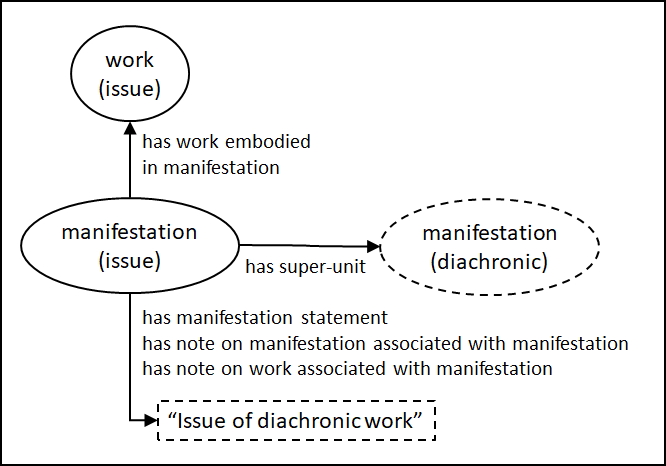
The diagram shows the issue of a diachronic work that is described as a separate related work. There is a choice to describe the manifestation that embodies the diachronic work as a separate related work, or to include the diachronic work or its manifestation in manifestation statements or notes for the manifestation that is being described. Optional entities, manifestation statements, and notes are outlined by dashes.
Manifestation that embodies a diachronic work
A manifestation cannot embody the expression of more than one diachronic work.
Consider a manifestation that embodies the expression of a diachronic work to be incomplete. The manifestation may be terminated by its producer or publisher before its intended completion.
Consider a manifestation that embodies the expression of a diachronic work that is known or assumed to have terminated to be a special case of an incomplete manifestation. The manifestation may be extended by its producer or publisher after its intended completion.
Consider a description of a manifestation that embodies the expression of a diachronic work to be incomplete. The attributes and relationships associated with the manifestation may be changed over time by its producer or publisher.
Record a has note on manifestation element that indicates the intention and status of completeness. [Full example: IFLA series on bibliographic control (2004-2012; De Gruyter Saur; volume). The note also includes information about enumeration.]Examples
Property Value has note on manifestation "First issue published in 2004 as volume 26; last issue published in 2012 as volume 45."
Record statements, notes, attributes, and relationships that reflect changes to the attributes and relationships that are common to manifestations of expressions of issues or iterations of a diachronic work.
Consider the manifestation that embodies the expression of a successive diachronic work to have complete sub-units that are the manifestations that embody the expressions of issues of the diachronic work.
Select the methods to use to describe each manifestation that embodies the expression of an issue or iteration of a diachronic work from the following options:
- Record the manifestation that embodies the issue or iteration as a separate manifestation and record a relationship to it with a has sub-unit element.
- Record a has manifestation statement element or element sub-type that includes information about the manifestation that embodies the issue or iteration.
- Record a has note on manifestation associated with manifestation element that includes a description of one or more manifestations that embody issues or iterations.
- Do not describe the manifestation that embodies the issue or iteration.
Describe the manifestation that embodies the issue or iteration with more than one method, if it is considered to be useful for users of the metadata. [Full example: New scientist. The collection (2014-; Reed Business Information Ltd; volume).]Examples
Property Value has sub-unit "Quantum world (2016; Reed Business Information Ltd; volume)" has note on manifestation associated with manifestation "Volume 3, issue 3 has title The quantum world."
Record a has note on work associated with manifestation element that includes a description of one or more issue works, if it is considered to be useful for users of the metadata.
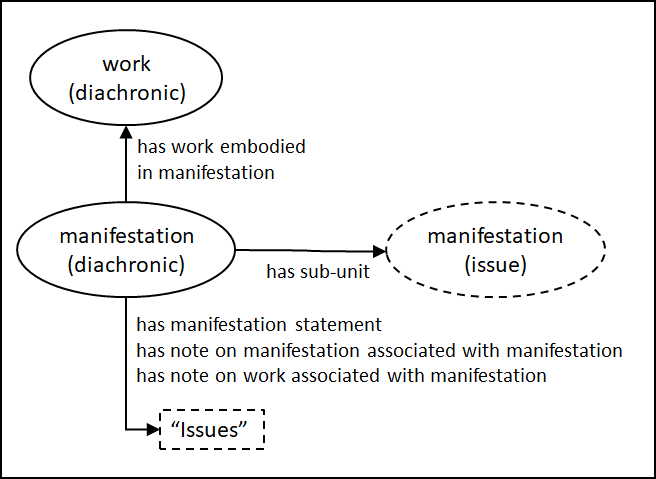
The diagram shows the diachronic work that is described as a separate related work. There is a choice to describe the manifestations that embody the issues of the diachronic work as separate related manifestations, or to include the issue work or its manifestation in manifestation statements or notes for the manifestation that is being described. Optional entities, manifestation statements, and notes are outlined by dashes.
Describing the manifestation
The following workflow is recommended for the creation of a description of a single manifestation after preliminary assessment of a resource.
-
How does the manifestation describe itself?
- ✽Record has manifestation statement elements
- ✽Record has manifestation statement of title and responsibility elements
- Record has note on manifestation statement elements
- ✽Record has manifestation statement elements
-
What appellations are used to label the manifestation?
- ✽Record has appellation of manifestation elements
- Record has title of manifestation elements
- Record has identifier of manifestation elements
- Record has access point of manifestation elements
- ✽Record has authorized access point of manifestation elements
- Record has note on nomen associated with manifestation elements
- ✽Record has appellation of manifestation elements
-
What are the details of the creation of the manifestation?
- Record has creator agent of manifestation elements
- Record has note on agent associated with manifestation elements
- Record has place of creation of manifestation elements
- Record has note on place associated with manifestation elements
- Record has date of creation of manifestation elements
- Record has note on time-span associated with manifestation elements
-
What are the details of the carrier, including extent?
- ✽Record a has unitary structure element
- Record has sub-unit elements
- Record has super-unit elements
- ✽Record has category of carrier elements
- ✽Record has media type elements
- Record has physical characteristic elements
- Record has note on category of manifestation elements
- Record has extent of manifestation elements
- Record has item that exemplifies manifestation elements
-
What are the details of the content that is embodied in the manifestation?
- Record has expression embodied in manifestation elements
- Record has work embodied in manifestation elements
- ✽Record has category of embodied content elements
- Record has note on expression associated with manifestation elements
- Record has note on work associated with manifestation elements
-
How is the manifestation related to other resource entities of the same resource?
- ✽Record has expression embodied in manifestation elements
- ✽Record has work embodied in manifestation elements
-
How is the manifestation related to other entities?
- Record relationship elements
- ✽Record has agent associated with manifestation elements
- ✽Record has creator agent of manifestation elements
- ✽Record has creator collective agent of manifestation elements
- ✽Record has creator person of manifestation elements
- ✽Record has creator agent of manifestation elements
- ✽Record has place associated with manifestation elements
- ✽Record has place of creation of manifestation elements
- ✽Record has time-span associated with manifestation elements
- ✽Record has date of creation of manifestation elements
- ✽Record has agent associated with manifestation elements
- Record other has entity associated with manifestation elements
- Record has note on entity associated with manifestation elements
- Record a is reference source of element
- Record a is subject manifestation of element
- Record relationship elements
-
What other information is considered to be useful for users of the metadata?
- Record attribute elements
- Record has note on manifestation elements